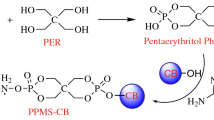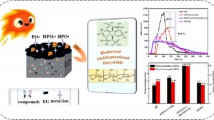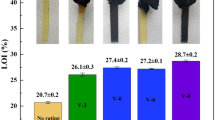Abstract
A novel mono-component intumescent flame retardant named pentaerythritol phosphate melamine salt (PPMS)-functionalized expandable graphite (PPMS-EG) was synthesized and carefully characterized by Fourier transform infrared spectroscopy, 1H nuclear magnetic resonance spectroscopy, scanning electron microscopy (SEM)–energy-dispersive X-ray spectrometry, and thermo-gravimetric (TG) analyses. Then, PPMS-EG was incorporated into epoxy resin (EP) to enhance fire safety. The flammability properties of EP composites were investigated by limiting oxygen index (LOI), UL94 vertical burning test, and cone calorimeter test. As expected, PPMS-EG imparts good flame retardancy to epoxy resin, and EP matrix with 20 mass% PPMS-EG passes the UL94 V-0 rating and the LOI value reaches 27.3%. Cone calorimeter test shows that the incorporation of PPMS-EG dramatically reduces the heat release and smoke production of EP, and the peak heat release rate and peak smoke production rate of EP composite with 15 mass% PPMS-EG are reduced by 68.7% and 46.3%, respectively, compared to those of EP. By comparison with either PPMS or expandable graphite, the same addition of PPMS-EG produces higher flame-retardant and smoke suppression efficiencies in EP matrix due to the formation of a more compact and intumescent char layer, as determined from digital photographs and SEM images. TG results show that PPMS-EG significantly enhances the thermal stability and char-forming ability of EP composites. Char residue analysis reveals that PPMS-EG positively contributes to the formation of more phosphorus-rich cross-linking char and aromatic char in the condensed phase, thus exhibiting a more thermally stable char against the release of heat and smoke. Overall, PPMS-EG can be used as a highly efficient mono-component intumescent flame retardant for preparing super flame-retarded EP composites.
Graphical abstract

















Similar content being viewed by others
References
Sut A, Greiser S, Jäger C, Schartel B. Synergy in flame-retarded epoxy resin. J Therm Anal Calorim. 2017;128(1):141–53.
Qiu S, Wang X, Yu B, Feng X, Mu X, Yuen RKK, Hu Y. Flame-retardant-wrapped polyphosphazene nanotubes: a novel strategy for enhancing the flame retardancy and smoke toxicity suppression of epoxy resins. J Hazard Mater. 2017;325:327–39.
Wang X, Hu Y, Song L, Xing W, Lu H, Lv P, Jie G. Flame retardancy and thermal degradation mechanism of epoxy resin composites based on a DOPO substituted organophosphorus oligomer. Polymer. 2010;51:2435–45.
Khalili P, Tshai KY, Hui D, Kong I. Synergistic of ammonium polyphosphate and alumina trihydrate as fire retardants for natural fiber reinforced epoxy composite. Compos Part B Eng. 2017;114:101–10.
Jiao C, Zhang C, Dong J, Chen X, Qian Y, Li S. Combustion behavior and thermal pyrolysis kinetics of flame-retardant epoxy composites based on organic-inorganic intumescent flame retardant. J Therm Anal Calorim. 2015;119:1759–67.
Bourbigot S, Le Bras M, Duquesne S, Rochery M. Recent advances for intumescent polymers. Macromol Mater Eng. 2004;289:499–511.
Zhao X, Gao S, Liu G. A THEIC-based polyphosphate melamine intumescent flame retardant and its flame retardancy properties for polylactide. J Anal Appl Pyrol. 2016;122:24–34.
Zhang F, Sun W, Wang Y, Liu B. Influence of the pentaerythritol phosphate melamine salt content on the combustion and thermal decomposition process of intumescent flame-retardant ethylene-vinyl acetate copolymer composites. J Appl Polym Sci. 2015;132:42148.
Makhlouf G, Hassan M, Nour M, Abdel-Monem YK, Abdelkhalik A. Evaluation of fire performance of linear low-density polyethylene containing novel intumescent flame retardant. J Therm Anal Calorim. 2017;130:1031–41.
Zhang P, He Y, Tian S, Fan H, Chen Y, Yan J. Flame retardancy, mechanical, and thermal properties of waterborne polyurethane conjugated with a novel phosphorous-nitrogen intumescent flame retardant. Polym Compos. 2017;38:452–62.
Tang M, Qi F, Chen M, Sun Z, Xu Y, Chen X, Zhang Z, Shen R. Synergistic effects of ammonium polyphosphate and red phosphorus with expandable graphite on flammability and thermal properties of HDPE/EVA blends. Polym Advan Technol. 2016;27:52–60.
Alongi J, Han Z, Bourbigot S. Intumescence: tradition versus novelty. A comprehensive review. Prog Polym Sci. 2015;51:28–73.
Wang X, Kalali EN, Wan J, Wang D. Carbon-family materials for flame retardant polymeric materials. Prog Polym Sci. 2017;69:22–46.
Li Y, Zou J, Zhou S, Chen Y, Zou H, Liang M, Luo W. Effect of expandable graphite particle size on the flame retardant, mechanical, and thermal properties of water-blown semi-rigid polyurethane foam. J Appl Polym Sci. 2014;131(3):1082–90.
Luo W, Li Y, Zou H, Liang M. Study of different-sized sulfur-free expandable graphite on morphology and properties of water-blown semi-rigid polyurethane foams. RSC Adv. 2014;4:37302–10.
Laachachi A, Burger N, Apaydin K, Sonnier R, Ferriol M. Is expanded graphite acting as flame retardant in epoxy resin? Polym Degrad Stabil. 2015;117:22–9.
Yang S, Wang J, Huo S, Wang M, Wang J, Zhang B. Synergistic flame-retardant effect of expandable graphite and phosphorus-containing compounds for epoxy resin: strong bonding of different carbon residues. Polym Degrad Stabil. 2016;128:89–98.
Wang N, Xu G, Wu Y, Zhang J, Hu L, Luan H, Fang Q. The influence of expandable graphite on double-layered microcapsules in intumescent flame-retardant natural rubber composites. J Therm Anal Calorim. 2016;123:1239–51.
Xi W, Qian L, Huang Z, Cao Y, Li L. Continuous flame-retardant actions of two phosphate esters with expandable graphite in rigid polyurethane foams. Polym Degrad Stabil. 2016;130:97–102.
Zheng Z, Liu Y, Zhang L, Wang H. Synergistic effect of expandable graphite and intumescent flame retardants on the flame retardancy and thermal stability of polypropylene. J Mater Sci. 2016;51:5857–71.
Liu Y, He J, Yang R. Effects of Dimethyl Methylphosphonate, Aluminum hydroxide, ammonium polyphosphate, and expandable graphite on the flame retardancy and thermal properties of polyisocyanurate-polyurethane foams. Ind Eng Chem Res. 2015;54:5876–84.
Zhu H, Zhu Q, Li J, Tao K, Xue L, Yan Q. Synergistic effect between expandable graphite and ammonium polyphosphate on flame retarded polylactide. Polym Degrad Stabil. 2011;96:183–9.
Han J, Liang G, Gu A, Ye J, Zhang Z, Yuan L. A novel inorganic-organic hybridized intumescent flame retardant and its super flame retarding cyanate ester resins. J Mater Chem A. 2013;1:2169–82.
Chen X, Zhuo J, Song W, Jiao C, Qian Y, Li S. Flame retardant effects of organic inorganic hybrid intumescent flame retardant based on expandable graphite in silicone rubber composites. Polym Adv Technol. 2014;25:1530–7.
Liu D, Zhong X, Shi X, Qi Y, Zhu T, Shao M, Zhang F. Pentaerythritol phosphate melamine salt, a new aggregating reagent for oilfield chemical sand control: preparation, properties, and mechanism. Energy Fuel. 2016;30:2503–13.
Fontaine G, Bourbigot S, Duquesne S. Neutralized flame retardant phosphorus agent: facile synthesis, reaction to fire in PP and synergy with zinc borate. Polym Degrad Stabil. 2008;93(1):68–76.
Wang G, Yang J. Influences of expandable graphite modified by polyethylene glycol on fire protection of waterborne intumescent fire resistive coating. Surf Coat Technol. 2010;204:3599–605.
Huang G, Chen S, Tang S, Gao J. A novel intumescent flame retardant-functionalized graphene: nanocomposite synthesis, characterization, and flammability properties. Mater Chem Phys. 2012;135:938–47.
Wang P, Yang F, Cai Z. Synergistic effect of organo-montmorillonite and DOPO-based oligomer on improving the flame retardancy of epoxy thermoset. J Therm Anal Calorim. 2017;128:1429–41.
Yan L, Xu Z, Wang X. Influence of nano-silica on the flame retardancy and smoke suppression properties of transparent intumescent fire-retardant coatings. Prog Org Coat. 2017;112:319–29.
Ye L, Meng X, Ji X, Li Z, Tang J. Synthesis and characterization of expandable graphite-poly(methyl methacrylate) composite particles and their application to flame retardation of rigid polyurethane foams. Polym Degrad Stabil. 2009;94:971–9.
Si M, Feng J, Hao J, Xu L, Du J. Synergistic flame retardant effects and mechanisms of nano-Sb2O3 in combination with aluminum phosphinate in poly(ethylene terephthalate). Polym Degrad Stabil. 2014;100:70–8.
Xu Z, Yan L, Liu D, Ni T, Peng J, Xu Y. Correlations between measurements of flame-retarded high-density polyethylene composites subjected to three conventional fire tests. In: Harada K, Matsuyama K, Himoto K, Nakamura Y, Wakatsuki K, editors. Fire science and technology 2015. Singapore: Springer; 2017. p. 599–607.
Yang A, Deng C, Chen H, Wei Y, Wang Y. A novel Schiff-base polyphosphate ester: highly-efficient flame retardant for polyurethane elastomer. Polym Degrad Stabil. 2017;144:70–82.
Shi Y, Yu B, Zheng Y, Guo J, Chen B, Pan Z, Hu Y. A combination of POSS and polyphosphazene for reducing fire hazards of epoxy resin. Polym Adv Technol. 2018;29(4):1242–54.
Li H, Hu Z, Zhang S, Gu X, Wang H, Jiang P, Zhao Q. Effects of titanium dioxide on the flammability and char formation of water-based coatings containing intumescent flame retardants. Prog Org Coat. 2015;78:318–24.
Xu Z, Chu Z, Yan L. Enhancing the flame-retardant and smoke suppression properties of transparent intumescent fire-retardant coatings by introducing boric acid as synergistic agent. J Therm Anal Calorim. 2018;133:1241–1252.
Murat Unlu S, Tayfun U, Yildirim B, Dogan M. Effect of boron compounds on fire protection properties of epoxy based intumescent coating. Fire Mater. 2017;41(1):17–28.
Yan L, Xu Z, Wang X. Synergistic effects of organically modified montmorillonite on the flame-retardant and smoke suppression properties of transparent intumescent fire-retardant coatings. Prog Org Coat. 2018;122:107–18.
Guan Y, Huang J, Yang J, Shao Z, Wang Y. An effective way to flame-retard biocomposite with ethanolamine modified ammonium polyphosphate and its flame retardant mechanisms. Ind Eng Chem Res. 2015;54:3524–31.
Yuan B, Fan A, Yang M, Chen X, Hu Y, Bao C, Jiang S, Niu Y, Zhang Y, He S, Dai H. The effects of graphene on the flammability and fire behavior of intumescent flame retardant polypropylene composites at different flame scenarios. Polym Degrad Stabil. 2017;143:42–56.
Wang P, Xia L, Jian R, Ai Y, Zheng X, Chen G, Wang J. Flame-retarding epoxy resin with an efficient P/N/S-containing flame retardant: preparation, thermal stability, and flame retardance. Polym Degrad Stabil. 2018;149:69–77.
Acknowledgements
This work was supported by the National Natural Science Foundation of China (No. 51676210), the Hunan Provincial Natural Science Foundation of China (No. 2018JJ3668), the Postdoctoral Science Foundation of Central South University, and the Project funded by China Postdoctoral Science Foundation (No. 2017M612587).
Author information
Authors and Affiliations
Corresponding author
Rights and permissions
About this article
Cite this article
Yan, L., Xu, Z., Wang, X. et al. Preparation of a novel mono-component intumescent flame retardant for enhancing the flame retardancy and smoke suppression properties of epoxy resin. J Therm Anal Calorim 134, 1505–1519 (2018). https://doi.org/10.1007/s10973-018-7810-x
Received:
Accepted:
Published:
Issue Date:
DOI: https://doi.org/10.1007/s10973-018-7810-x




